
Description
SYSCALL instruction refers to System Calls which is intended for Privilege Level 3 to access OS or executive procedures running at Privilege level 0. This post is a walkthrough on how SYSCALL is done under the hood in Intel architecture. We will see how the different privilege levels would be adjusted to kernel mode.
I have made heavy references to the Intel Manual combined (5k++ pages). I have added keywords to search for as well for future reference.
TL;DR
Check if 64-bit mode, long mode, and syscalls are enabled; otherwise, terminate. Save state in RCX, RIP, R11, and mask RFLAGS. Configure Code (CS) and Stack (SS) segments with proper limits, types, and privilege levels. Wait for expected instructions if CET is supported. Finalize syscall by transitioning to target RIP.
SYSCALL - Fast System Call
- This instruction is a way for usermode process to invoke functions in the kernel
- We can search for “Fast System Calls in 64-Bit Mode”
| Opcode | Instruction | Op/En | 64-Bit Mode | Compat/Leg Mode | Description |
|---|---|---|---|---|---|
| 0F 05 | SYSCALL | ZO | Valid | Invalid | Fast call to privilege level 0 system procedures. |
Instruction Operand Encoding
| Op/En | Operand 1 | Operand 2 | Operand 3 | Operand 4 |
|---|---|---|---|---|
| ZO | N/A | N/A | N/A | N/A |
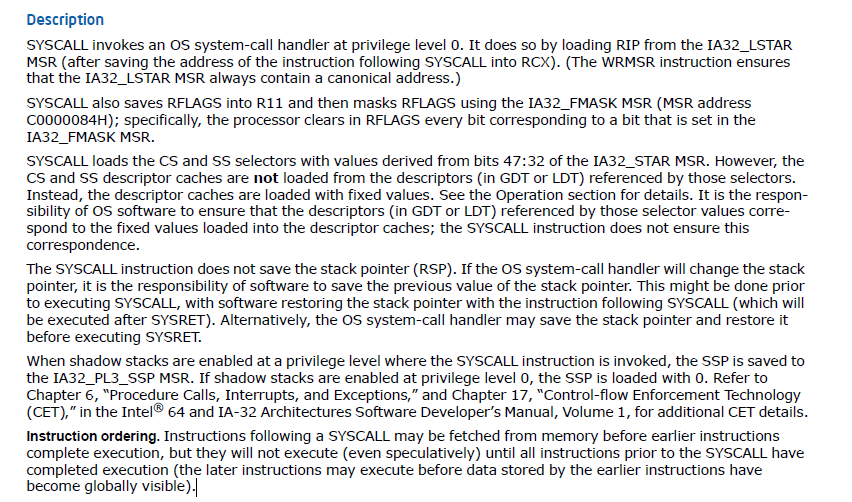
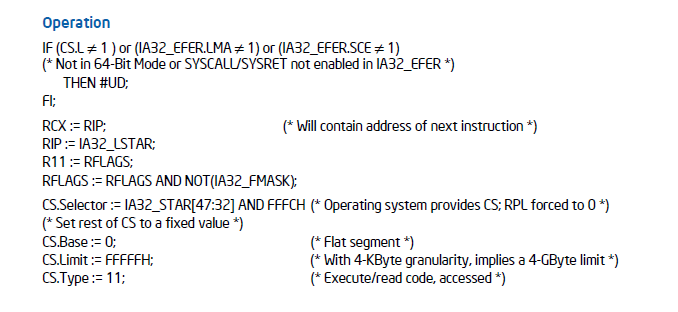
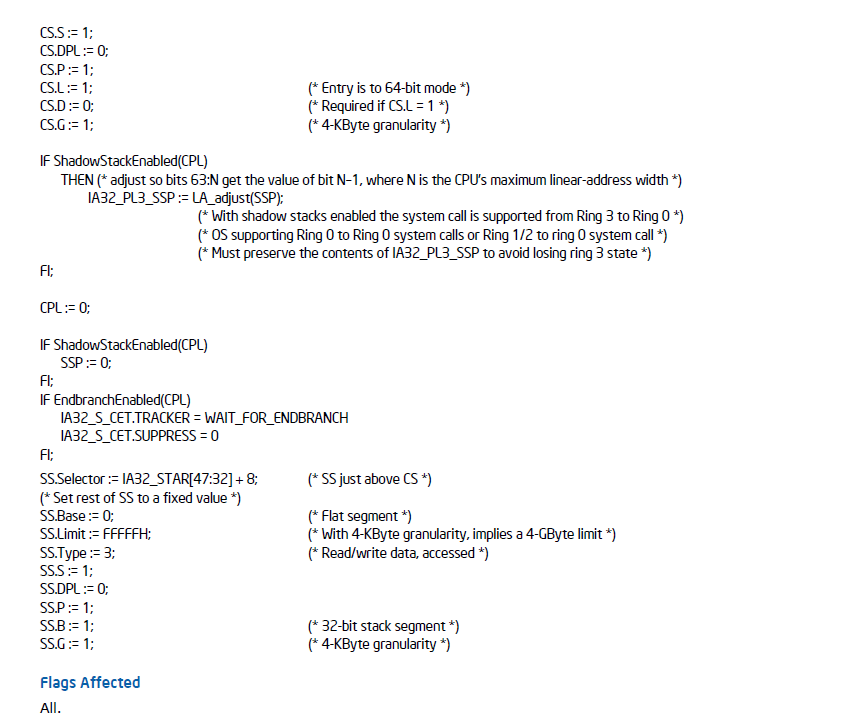
SYSCALL Flow
Step 1: Check Preconditions
IF NOT (is_64bit_mode AND Long_Mode_Active AND syscall_enabled) THEN
Undefined_Operation
ENDIF
Step 2: Save Current State
RCX = Current_Instruction_Pointer # Save RIP to RCX
RIP = Target_Instruction_Pointer # Populate RIP with the 64-bit target instruction pointer
R11 = RFLAGS # Save current RFLAGS to R11
RFLAGS = RFLAGS AND ~IA32_FMASK # Mask RFLAGS using IA32_FMASK from MSR (C000_0084)
More about RFLAG which is extended of EFLAG.
Step 3: Setup Code Segment (CS)
CS.Selector = IA32_STAR[47:32] AND 0xFFFC # Extract selector and clear TI and RPL bits
CS.Base = 0 # Set CS base to 0
CS.Limit = 0xFFFF # Set CS limit for 4GB (granularity enabled)
CS.Type = 0b1011 # Set Type: Execute/Read, Accessed, Non-Conforming
CS.S = 1 # Mark as Code/Data Segment
CS.DPL = 0 # Descriptor Privilege Level = 0 (Kernel Mode)
CS.P = 1 # Mark as Present
CS.L = 1 # Enable 64-bit mode
CS.D = 0 # Clear Default Operand Size
CS.G = 1 # Set 4K Granularity
Step 4: Check for Shadow Stack and CET
IF ShadowStackEnabled THEN
SSP = Canonicalize(IA32_PL3_SSP) # Canonicalize Linear Address for SSP
ENDIF
IF CET_Enabled THEN
IF EndBranch_Enabled THEN
CET.Tracker = WAIT_FOR_ENDBRANCH # Set CET Tracker to WAIT_FOR_ENDBRANCH
CET.Suppress = 0 # Clear CET Suppress (Enable CET Enforcement)
ELSE
CET.Tracker = IDLE # Set CET Tracker to IDLE
CET.Suppress = 0 # Clear CET Suppress (Enable CET Enforcement)
ENDIF
ENDIF
Step 5: Setup Stack Segment (SS)
SS.Selector = IA32_STAR[47:32] + 8 # Extract SS selector
SS.Base = 0 # Set SS base to 0
SS.Limit = 0xFFFF # Set SS limit for 4GB (granularity enabled)
SS.Type = 0b0011 # Set Type: Read/Write, Accessed, Expand-Up Data
SS.DPL = 0 # Descriptor Privilege Level = 0 (Kernel Mode)
SS.P = 1 # Mark as Present
SS.B = 1 # Mark as Big (32-bit stack operations)
SS.G = 1 # Set 4K Granularity
Long Winded with Reference to Intel Manual
-
IA32_EFER.SCE/SYSCALL Enable flag is not set OR IA32_EFER.LMA/IA-32 mode is active is not set or
CS.L(Not in 64 bits) , then its undefined operation.- To do so, we can check
(CPUID.80000001H.EDX[bit 11] = 1). - According to Intel Manual
If CS.L = 0 and IA-32e mode is active, the processor is running in compatibility mode.
- To do so, we can check
-
RCX stores RIP (next instruction from current)
-
RIP populated with 64 bits Target Instruction Pointer
-
R11 get RFLAGS value
- More about RFLAG which is extended of EFLAG.
-
RFLAGS updated with and ~IA32_FMASK
IA32_FMASKcan be taken viaC000_0084from IA-32 MSR.IA32_FMASK (R/W)is AKA System Call Flag Mask (R/W) from Table 2-2. IA-32 Architectural MSRs . we should have it:If CPUID.80000001:EDX.[29] = 1- This is used to clear out bits that should not be carried over during transitions
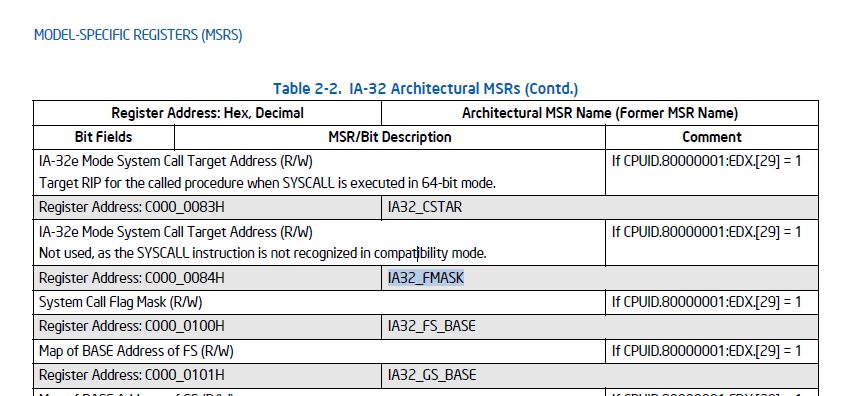
-
The Code Segment Selector value is taken from
IA32_STAR[47:32] & 0xFFFC- The following shows the
IA32_STARlayout 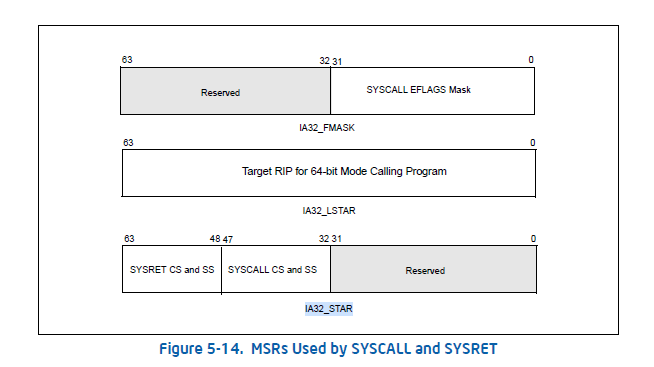
- The following shows the
-
The reason to clear the first two bits is because they are
TIandRPLTIrefers to Table Indicator (0 → GDT, 1→ LDT)RPLrefers to Requested Privilege Level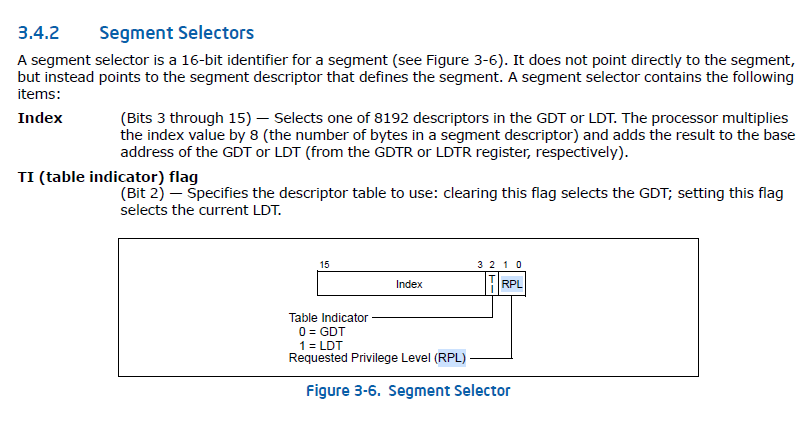
-
Set the base of CS to 0 - Search Intel Manual with “Code-Segment Descriptor in 64-bit Mode”
-
Set the limit to 0xFFFF - Check “Limit Checking” in Section 5.3
- 0xFFFF means that the G Flag is set with 4 KByte page granularity
- and therefore, the lower 12 bits of segment offset (address) are not checked against the limit.
- Limit:
FFFH (4 KBytes) to FFFFFFFFH (4 GBytes).
- 0xFFFF means that the G Flag is set with 4 KByte page granularity
-
Sets the Type as well to numerical value 11 whose binary is
0b1011- TL;DR - This sets the code segment to be non-conforming but executable and marking the segment as (A)ccessed making it wr
- According to Intel Manual :
CS.Type is set to 11 (execute/read, accessed, non-conforming code segment). C(0) refers to this being a non-conforming segment.- Non conforming segment will require the DPL to equal its RPL
- According to Intel Manual
If the selected code segment is at a different privilege level and the code segment is non-conforming,a general-protection exception is generated.
- According to Intel Manual
- Note that conforming segment grants far CALL or far JMP instruction access to its segment descriptor. It also allows access from any privilege level that is equal to or greater (less privileged) than the
DPLof the conforming code segment.
- Non conforming segment will require the DPL to equal its RPL
R(1)is set to ReadableA(1) refers to Accessed (Executable)
-

-
Can check out more from “PRIVILEGE LEVEL CHECKING WHEN ACCESSING DATA SEGMENTS”
-
CS.Shere refers to the Descriptor type (S) Flag for bit 12- See if the segment descriptor is for a system segment or a code or data segment
The CS register only can be loaded with a selector for a code segment.This is set to define this segment as code or data segment.
-
CS.DPLis set to 0DPLis Descriptor Privilege Level which is the privilege level of a segment or gate.- This sets the privilege to the lowest (Kernel mode)
-
CS.Pis set to be present -
CS.Lis set as 64 bits mode -
CS.Dis set to 0 as required -
CS.Gis set to 1 for 4Kbyte granularity -
Checks if
ShadowStackEnabledwith the current privilege level -
This is used for CET if enabled.
-
There is a Shadow Stack Pointer (SSP) which contains task’s shadow stack pointer.
IA32_PL3_SSPis used to store the canonicalized address viaLA_adjustwhere LA stands for Linear Address.- is present
If CPUID.(EAX=07H,ECX=0H):ECX.CET_SS[07] = 1 - This means that we can see if this is enabled from CPUID
- PL3 refers to Privilege Level (User Mode) which is used to load the linear address into SSP on transition to privilege level 3 (R/W).
- Find the sequence of near indirect CALL instruction by searching:
Instructions sequentially following a near indirect CALL instruction (i.e., those not at the target) may be executed speculatively.- It will adjust
64:48in 64 bits with 4kbytes Page in a 4 level paging.
- is present
CPL- Current Privilege Level is set to 0 (Kernel Mode)- If the ShadowStack is enabled with CPL level of 0, then set to 0
- If End Branch 64 bit (
ENDBR64) is enabled with currentCPL(Kernel) - This is the instruction terminates an indirect branch in 64 bit mode. Since the
CPLat this point is 0, then it would set an IDLE state for kernel mode. The Supervisor CET suppress bit is cleared, enabling CET enforcement for supervisor (kernel) mode. 
- If the endbranch is enabled, then the CET Tracker would be changed to
WAIT_FOR_ENDBRANCH. TheTRACKERrefers to CET’s ability to track Control Flow like indirect branch tracking.- In the
WAIT_FOR_ENDBRANCH, the indirect branch tracking state machine verifies the next instruction is an ENDBR32 instruction in legacy and compatibility mode, or ENDBR64 instruction in 64-bit mode. This is important for CET since it is responsible for throwingControl Protection Exceptionor Mnemonic#CPwhen there is a missingENDBRANCHinstruction at target of an indirect call or jump. - The following show the flow for
EndbranchEnabledaccording to https://kib.kiev.ua/x86docs/Intel/CET/334525-003.pdf 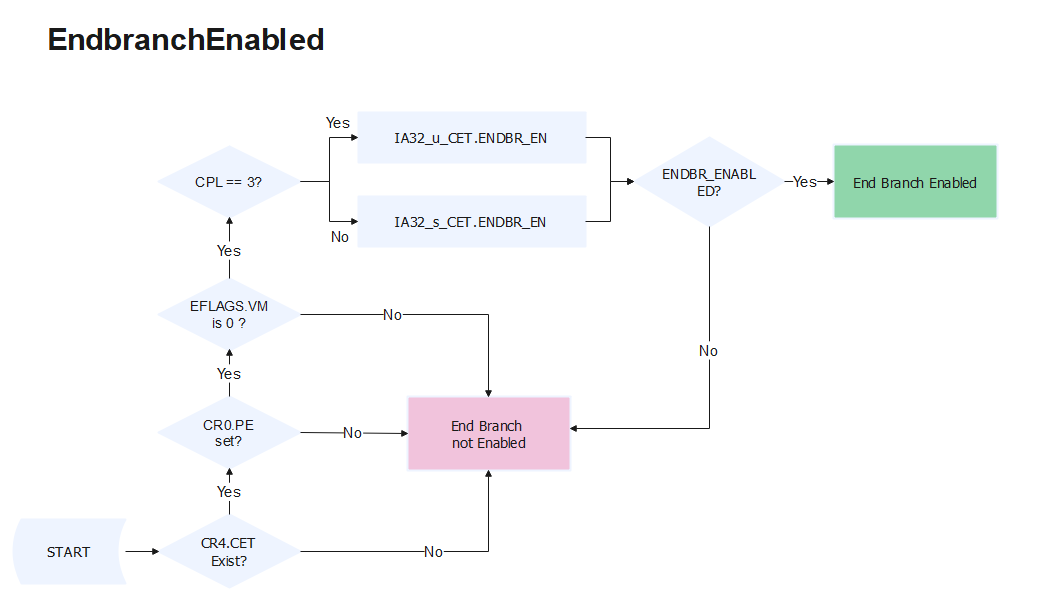
- In the
-
SS- Stack Segment is retrieved fromIA32_STAR[47:32]+8 -
Similar to
CS,SS.Baseis set to 0 andSS.Limitto 4Gb limit by setting to 1 -
The
SS.Typeis set to numerical value3which is0b0011- This is according to documentation and set Descriptor type (S) Flag for bit 12
(read/write, accessed, expand-up data segment).
-
SS.DPLis set to 0 (Kernel mode) -
SS.Pis set to 1 is set to present -
SS.Brefers toBigStacks in expand-up segments with the G (granularity) and B (big) flags in the stack-segment descriptor clear.
-
SS.Gto 4KByte Granularity -
Transition to the Target Instruction Pointer in
RIP
Appendix
EFER - Extended Feature Enable Register
IA32_EFER MSR provides several field related to IA-32e mode enabling and operation. There are four bytes that are important:
- IA32_EFER.SCE (R/W) — (Pos 0) ^d26e06
- SYSCALL Enable
- IA32_EFER.LME (R) — (Pos 8)
- IA-32e Mode Enable
- IA-32_EFER.LMA - IA-32e Mode — Active (Pos 10) ^11f1ef
- IA-32e mode is active when set
- IA32_EFER.NXE (R/W) - Execute Disable Bit Enable — (Pos 11)
- Enable page access restrictions by preventing instruction fetches from PAE pages with the XD bit set
EFLAGS Register
2-10 Vol. 3A
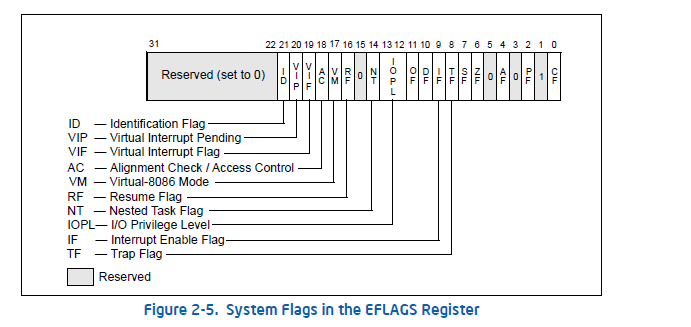
Conclusion
Definitely had a better appreciation of the Intel Manual when it comes to searching up information about the architecture. It is definitely good to open the combined version and search up based on keywords as well. With that, it has helped me understand the syscall instructions a little better.